User:Alexis
When did oil paints become popular?
While the dating of oil paint's origins are still under scrutiny, the technique of oil painting became widely popular during the fifteenth century. The medium, which revolutionized painting, supplanted the previously popular medium of tempera paint and afforded artists with greater versatility in their compositions in terms of the coloristic effects they could convey.
Recent Discoveries
While Europeans have been credited throughout history with having developed and popularized the medium of oil paints, recent discoveries suggest that eastern cultures might have used the medium well in advance of their western neighbors.
Archaeological research performed in the early 2000s in the Bamiyan Valley in central Afghanistan uncovered examples of wall painting executed in oil paint that date to perhaps as early as the fifth century CE. These caves were once lavishly decorated and accompanied two spectacularly colossal statues of the Buddha. Though these sculptures, once considered by most as truly exceptional representations of early Buddhist art, were demolished by the Taliban in 2001, the surviving art documented in these surrounding chambers updates the larger cultural history of the medium of oil paints to propose that their popularity in other parts of the world soared much earlier than previously believed. [1]
Perils of Oil Paints
In addition to its longer drying time, oil paints unfortunately suffer the test of time much more poorly than paintings rendered in other media. Oil paints, for instance, are much more susceptible to discoloration and oxidation, which can cause compositions over time to lose aspects of their appeal. [2]This would have been an unknowable characteristic during the early days of the medium's use, but it has encouraged a greater study of conservation methods to both preserve and restore the colors to their original glory. As a result, the popularity of oil paint remains unfazed, its only modern competitor perhaps the realm of the digital.

